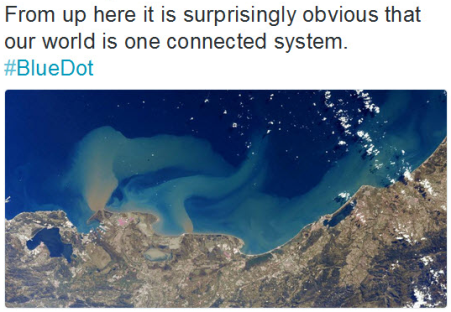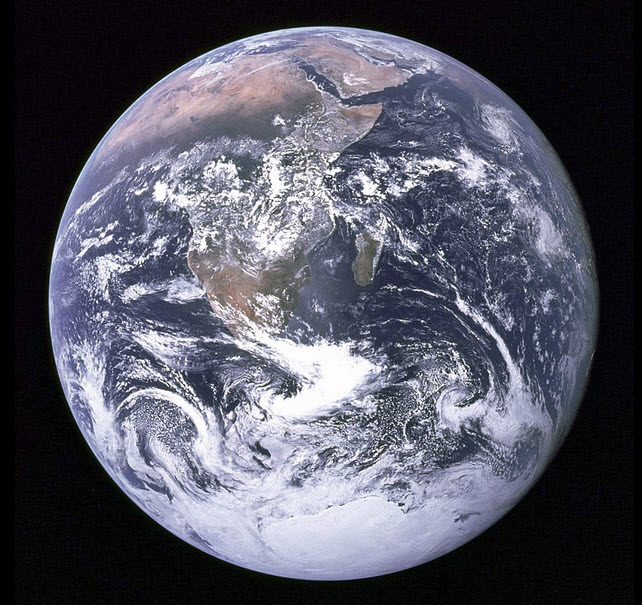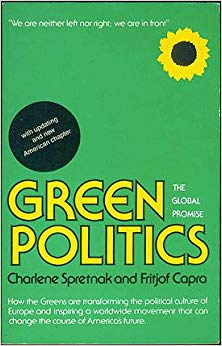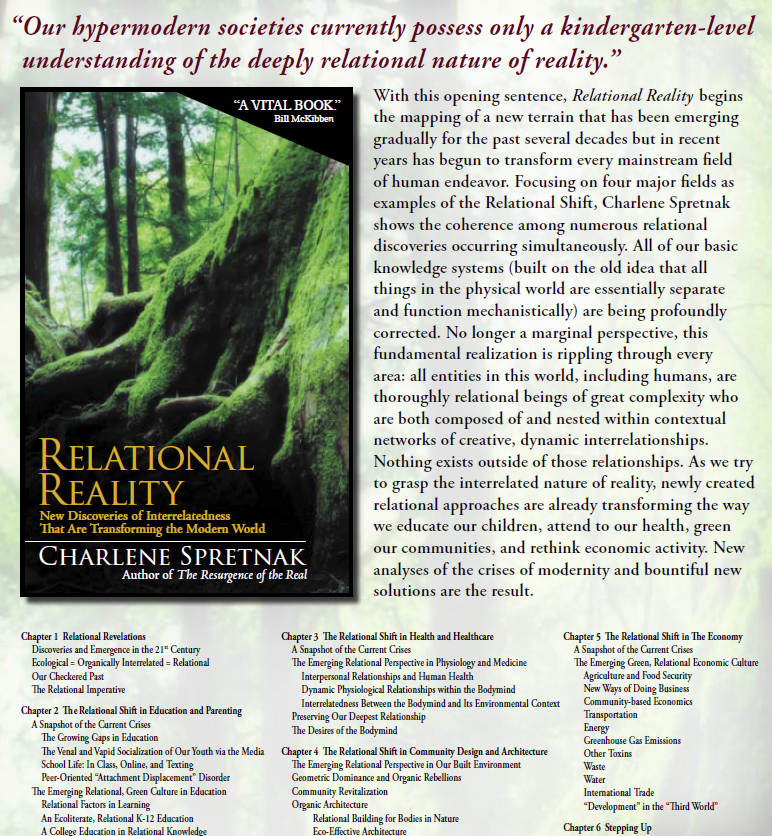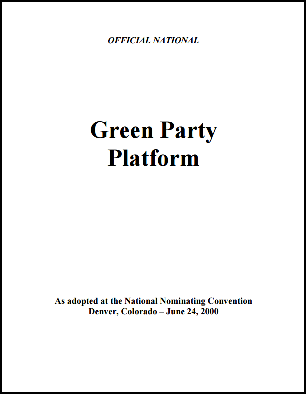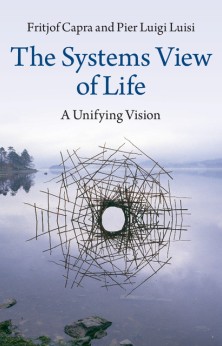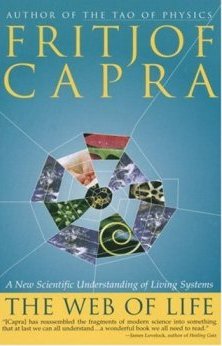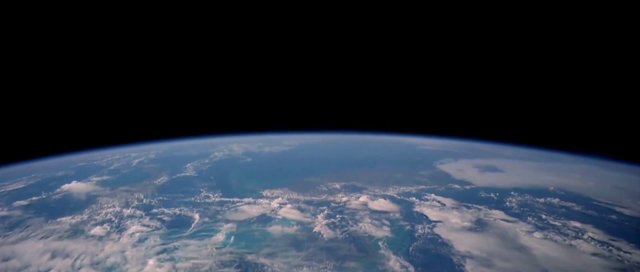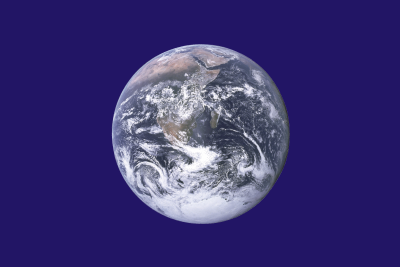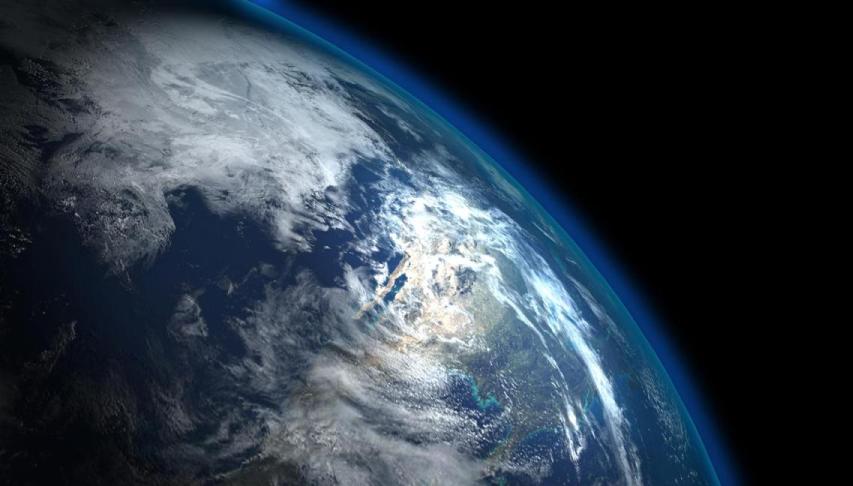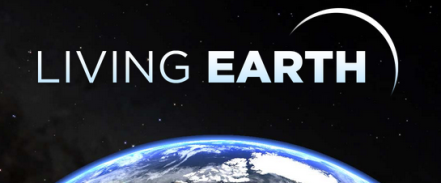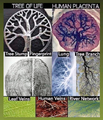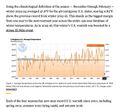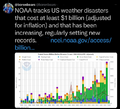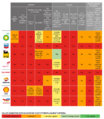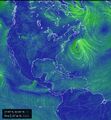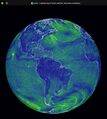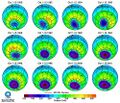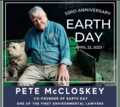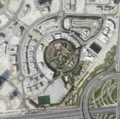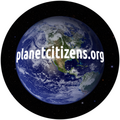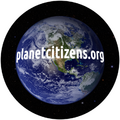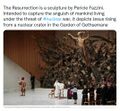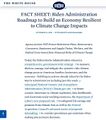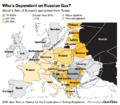Category:Environmental Protection
- And I think to myself, what a wonderful world
- ○ ○ ○ ○ ○ ○ ○ ○ ○ ○ ○ ○ ○ ○ ○ ○ ○ ○ ○ ○ ○ ○ ○ ○
Noel Preston: On my study wall there hangs a beautiful photograph taken by the crew of Apollo 17 during their space journey to the moon. It shows Earth our home, the blue planet set against the inky blackness of space. Earth appears as a ball-like, single organism.
We are a privileged generation to have this image and, associated with it, an understanding of the cosmos in its magnificence.
But we are also the generation that is responsible for unprecedented damage to Earth‟s life systems – a system that has been almost five billion years in the making. In our time, the collision between our human story and the Universe story demands some accounting and reconciliation, as well as a revision of the narratives by which we live.
Keywords: spiritual ecology; cognitive shift; new ways of seeing; relational reality
Environmental Protection, Environmental Security ... Interconnected, Intergenerational...
"It's All Related"
~ Eco-Politics, Relational Reality
"Relational Reality"
○
A Green Philosophy, Green Living
Charlene Spretnak
○
Fritjof Capra -- Is There Room for Spirit in Science? & Charlene Spretnak -- The Spiritual Dimension of Green Politics / Relational Reality
Green Politics
by Charlene Spretnak & Fritjof Capra
Relational Reality, Green Values & the Green Platform
- SJS / Siterunner: It's all connected, it's all related.
"It's All Connected"
SJS/GreenPolicy Siterunner: In the early, formative years of the Bioneers, our group of 'bio pioneers' looked to nature's lessons as guides for knowledge and action. We often talked about how "It's all connected, it's all related" as we went about our organizing work, writing, and publishing. Today, Bioneers continues in its third decade. The message continues on, learning from nature, sharing lessons, an integral ecology and wisdom that is deep and needed in our time.
In the 1990s your GreenPolicy360 siterunner brought these ideas of interconnectedness into the drafting of the US Green Party platform, and Global Green Charter. I began my green writing with an understanding of building on a strong and lasting foundation. This was a values foundation and a core set of green values, that grew to become the new platform's Green Key Values (KVs).
I was fortunate, having moved from Los Angeles in 1987, to Santa Fe, New Mexico to be introduced to the work of Charlene Spretnak and her Santa Fe publisher at the time, Bear & Company.
Charlene's work to bring forward the original Green Key Values was inspirational to me.
Beginning in the 1990s in Santa Fe, I set to work on developing a "serious, credible, platform-based" U.S. Green Party. Our green politics group explored the initial Green Party roots and work of Charlene Spretnak, including the "key values" statement that was a foundation from the 1980s for the Green Party. Charlene and the women who pulled together a values foundation for the policy and positions to be developed became my own starting point in proposing, then drafting the founding Green Party platform.
Connectivity, as we were exploring in Santa Fe with the Bioneers, the Santa Fe Institute, St John's "Great Books" program, joined up with an political strategy that I carried over from the Brown presidential campaign of 1992. A whole earth perspective and an 'eco-nomics' were far along ib our thoughts. These core values, ideas and positions brought together a "tapestry of threads".
We proposed a national Green meeting a plan that I presented for a "40 state organizing effort". The strategy was adopted, including a proposal for a new platform, a presidential campaign, a first nominating convention (in Los Angeles, the "city of angels".) High hopes were floated and incorporating extensively from the works I drew from History of Ideas study at the Graduate Faculty of the New School in NYC, became a basis for the Green platform. Tying ideas together was a Whole Earth philosophy, one of seeing a big picture, and relationships that draw us together as 'planet citizens'. Connectivity based on values, a "relational reality" became a key element as I drafted an initial platform from 1995 to 2000. The comprehensive Green platform was adopted in 2000, on the cusp of a new century and millennium, as the US Green Party was formed and in 2001 formally approved as a "national committee of a national party" by the US Federal Election Committee.
Green concepts of living systems, 'it's all related' connectedness, go far beyond Green parties. A green perspective is vital and vitally needed, a new vision for the 21st century, of common bonds, protecting and preserving life, valuing the use of science and physics and acknowledging the challenges we all face in our Anthropocene era. Planet Earth is literally "in human hands".
Earth system science and relational reality, in a values vision of inter-connectedness and "the Commons", continue at the heart of our green politics and global green work.
'It's all connected' is green politics, a web of life, relational reality in our world.
○ ○ ○ ○ ○ ○ ○ ○ ○ ○ ○ ○ ○ ○ ○ ○ ○ ○ ○ ○ ○ ○ ○ ○ ○ ○ ○ ○ ○ ○ ○ ○
Charlene Spretnak: We are part of nature, not on top
• http://www.greenpolicy360.net/mw/images/Green_Key_Values_Spiritual_Dimensions-Spretnak-1.pdf
• http://www.greenpolicy360.net/mw/images/Green_Key_Values_Spiritual_Dimensions-Spretnak-2.pdf
• http://www.greenpolicy360.net/mw/images/Green_Key_Values_Spiritual_Dimensions-Spretnak-3.pdf
Green Values: A Green Platform Foundation
The Ten Key Values of the Green Party of the US: The 'KVs' of the Founding Platform
The U.S. Green Party "Ten Key Values"
The Ten Key Values of the Green Party of the US are often referred to as "the KVs" and act as a values foundation for the policy platform of the Green Party.
The Key Values were approved in 2000 at the national party convention in Denver, CO along with the founding national Green political platform.
○ ○ ○ ○ ○ ○ ○ ○ ○ ○ ○ ○ ○ ○
Steven Schmidt - GreenPolicy Siterunner writing to Charlene Spretnak in the Green Horizon Magazine, Fall - 2013
As the person who held a serious responsibility in redrafting the Key Values statement and changing the question format that came out of the 1984 Green meeting, I can say (and have said in numerous speeches, talks, articles and posts) that the Key Values are the values foundation on which we constructed our founding national Green Party Platform.... I often have explained our Green Key Values underpinning in speeches and in my writing over the years. The values of the Greens are a beginning point, an appropriate and a deeply held core set of beliefs that suffuse our platform... I was careful as I drafted platform language during these initial years and engaged with Greens in an extended process. I always pointed out the special, distinguishing role the Key Values hold...
- Steven J Schmidt
- Clearwater, Florida
○
The challenge was to construct a successful model on which to build a growing, vital, U.S. Green party. The model adopted came from an unlikely place: a small state in the hinterland far from centers of power. In 1994 in Santa Fe, named after St. Francis of Assisi, the patron saint of the land and animals, the New Mexico Green party proposed a statewide slate of Green candidates that would run a serious and credible campaign based on their founding platform. The campaign was one of the most successful independent, third-party efforts in the United States in nearly four decades and became a model for the national Green “40-State Organizing Effort” launched in December 1994, which led to the founding of the national Green platform and the first presidential campaign in 1996.
-- SJS / 2014
As I look back at the drafting of the U.S. Green Party's Key Values adopted formally as I presented them to the 2000 national Green Party Convention in Denver, along with the founding Green Party national platform, it remains for future greens, whether formally affiliated with the Green Party in the US or greens who share core values of Green parties to do their best in bringing the values and positions of green thought into reality.
The politics of the present era clearly demand the independent, future-oriented vision of green, environmentally focused 'planet citizens'...
-- SJS / 2015
○
The drafting of the Key Values in the 2000 Green Party Platform
History of US Green Party Founding Platform & First Presidential Campaign
- German Historical Institute / Boll Foundation
- Green Parties Conference, Published 2006
US Green Party National Platform - Official National Platform
Approved in 2000 / National Green Party Convention / Denver, CO
Green Party founding platform / 2000 / PDF
○ ○ ○ ○ ○ ○ ○ ○ ○ ○ ○ ○ ○ ○ ○ ○ ○ ○ ○ ○ ○ ○ ○ ○ ○ ○ ○ ○ ○ ○ ○ ○ ○ ○ ○ ○
Science & Spirit: New Ways of Seeing & Being
Is There Room for Spirit in Science?
Book Review: A Systems View of Life by Fritjof Capra and Pier Luisi
I am sure Fritjof Capra will need no introduction for the vast majority of you, as he is one of the world’s leading thinkers in systems theory, and the author of so many influential books such as The Tao of Physics -- The Web of Life: A New Synthesis of Mind and Matter -- The Turning Point: Science, Society and the Rising Culture -- The Hidden Connections: A Science for Sustainable Living and Learning from Leonardo: Decoding the Notebooks of a Genius.
Fritjof has described The Systems View of Life as “the realisation of a dream” and it has been written with his friend and long-time collaborator Pier Luigi Luisi who is one of the world’s leading authorities on the origin of life and self-organisation of synthetic and natural systems. The result is a text-book which presents, for the first time, a coherent systemic framework which integrates four dimensions of life – biological, cognitive, social and ecological.
It then discusses the profound philosophical, social and political implications of this new paradigm...
If we begin with some basics, this is first and foremost a textbook written in an academic style with numbered sections for easy cross-referencing, and is therefore targeted at undergraduate and post-graduate university students. It will of course also be of interest to researchers, practitioners and enquiring readers who are interested in discovering more about the profound shift in the scientific conception of living systems, the primary insight of which is the move from the machine metaphor of life to one where life is perceived as a network of inseparable relationships.
This primary insight looks quite innocuous in the written word, and it may be that people, in our highly-networked world, may wonder what the fuss is about. The shift becomes more pronounced when understood in terms of autopoiesis, one of the major foundations of the systems view of life, developed by Humberto Maturana and Francisco Varela in the 1970s.
In this view, living systems continually recreate themselves by transforming or replacing their components. They go through structural changes while preserving their web-like pattern of organisation. Hence there is both stability and change – a key characteristic of life. Instead of thinking of “mind” we change to a conception of the process of cognition. This has developed into a rich field known as cognitive science which transcends the traditional frameworks of biology, neuroscience, psychology, epistemology etc.
- The central insight is the identification of cognition (the process of knowing) with the process of life. Cognition is the activity involved in the self-generation and self-perpetuation of living networks. The interactions of a living organisation with their environment are cognitive actions. Cognition is immanent in matter at all levels of life.
- The brain is not the only structure through which the process of cognition operates, the entire structure of the organism participates in the process of cognition. The first scientific theory which overcomes the Cartesian split of mind and matter which are now seen as two complementary aspects of life which are inseparably connected.
Part I of the book examines the mechanistic world view, not only providing a much-needed historical perspective on science, from antiquity to our modern era. Right from the start, the authors note that:
- Physics, together with chemistry, is essential to understand the behaviour of the molecules in living cells, but it is not sufficient to describe their self-organising patterns and processes. At the level of living systems, physics has thus lost its role as the science providing the most fundamental description of reality. This is still not generally recognised today.
This book can be seen as a synthesis of all of Fritjof’s previous works into one unifying framework, perhaps notably The Web of Life... it is also an integration of the last couple of decades’ scientific developments...
To read The Systems View of Life is to journey through a study of order and complexity in the living world, understanding the shift from a mechanistic world view where quantification is primary, to understanding the behavioural qualities of complex and chaotic systems, arriving at the understanding the patterns of organisation and processes of living systems.
In systems thinking therefore, “organization, structure and process are three different but inseparable perspectives on the phenomenon of life.” The problem though, for many scientists, and also people who are involved in modeling complex systems, is that they do not give these three perspectives equal importance “because of the persistent influence of our Cartesian heritage.”
There is a fourth perspective which is added to these three domains, and that is the domain of meaning. Social networks are “first and foremost networks of communication involving symbolic language, cultural constraints, relationships of power and so on.” In adding this domain, the systems view of life in extended into an analysis of power, social structures, leadership, communities and the concept of the living organisation.
A whole chapter is dedicated to the inexhaustible topic of the relationship between science, religion and spirituality. While there are frameworks such as the integral theory of Ken Wilber which make claim of being a “theory of everything”, The Systems View of Life takes a measured and contemplative path looking at the areas of agreement, and also disagreement, such as the Buddhist perspective on consciousness whereby consciousness is seen as not emerging from either the brain or matter.
The important insight in this section is the way in which spirituality is defined as something separate from religion, thereby integrating human values into the overall systems approach. This includes the concept of ecoliteracy – “our ability to understand the basic principles of ecology, or principles of sustainability” – not just an intellectual understanding, but the deep ecological awareness of the fundamental interdependence of all phenomena and of the fact that, as individuals and societies, we are embedded in, and dependent upon, the cyclical processes of nature.
Since this awareness, ultimately, is grounded in spiritual awareness, it is evident that ecoliteracy has an important spiritual dimension.
The Systems View of Life examines the ecological dimension, and this includes a look at how sustainability is defined and taught, the manner in which global problems are interconnected, the fallacy of unlimited economic growth, global finance, as well as offering a number of systemic solutions to the problems of energy, climate change, industrial agriculture and biomimicry and ecodesign... Many of these solutions are technically and financially viable, the impediments are political will and the lobbying power of the US fossil-fuel industry...
The unified approach of The Systems of View of Life can contribute greatly to an analysis of the interrelations, especially as it has at a fundamental level both cognition and consciousness, a dimension which is vital in understanding the growing unrest and popular protests which are now emerging across this vast country to give just one example.
One recurrent theme discussed by systems practitioners though is the question of why it is so difficult to help people make the jump from a mechanistic world view to a networked world view.
In this new systems view of life, we have to change our understanding of living systems as machines to a view where cognition plays a role in dynamic... processes: Cognition, then, is not a representation of an independent existing world, but rather a continual bringing forth of a world through the process of living.
The Systems View of Life: A Unifying Vision is a book which it is hard to do justice to. For those already acquainted with a systems thinking background, there is much to contemplate, and there is of course plenty of reference material to explore in further detail for future study. For students the book provides an indispensable and I feel unequalled introduction to contemporary systems theory, a university textbook I did not have access to but would have loved to have had in the late 80s and early 90s...
Now with collaboration across governments, businesses and civil society, we can make the transition to a sustainable future, one which embraces “qualitative growth” enriching humanity and the environment with prosperity and a higher level of conscientiousness, one that truly understand the rich web of life.
○ ○ ○ ○ ○ ○ ○ ○ ○ ○ ○ ○
Alan Hunt Badiner - https://www.goodreads.com/book/show/711657.Dharma_Gaia
Thomas Berry - https://www.goodreads.com/book/show/209222.The_Dream_of_the_Earth
Fritjof Capra - https://www.goodreads.com/book/show/18554985-the-systems-view-of-life (see review above)
- Fritjof Capra & Charlene Spretnak - Green Politics: The Global Promise
- "We are neither left nor right; we are in front"
Matthew Fox - https://www.goodreads.com/book/show/530454.Creation_Spirituality
Buckminster Fuller - https://www.goodreads.com/book/show/316362.Operating_Manual_for_Spaceship_Earth
Thích Nhất Hạnh - https://www.goodreads.com/book/show/3075841-the-world-we-have
Hazel Henderson - https://www.goodreads.com/book/show/209976.Planetary_Citizenship
James Lovelock - https://www.goodreads.com/book/show/274234.Gaia_and_the_Theory_of_the_Living_Planet
Joanna Macy - https://www.goodreads.com/book/show/19237630-greening-of-the-self
Catriona MacGregor - https://www.goodreads.com/book/show/5945379-partnering-with-nature
John Muir - https://www.goodreads.com/book/show/17824069-john-muir
○
David Suzuki - https://www.goodreads.com/book/show/248755.The_Sacred_Balance
"Surviving Progress"
Sarah McFarland Taylor - https://www.goodreads.com/book/show/622894.Green_Sisters
Edward O. Wilson - https://www.goodreads.com/book/show/20665570-the-meaning-of-human-existence
○ ○ ○ ○ ○ ○ ○ ○ ○ ○ ○ ○ ○ ○ ○ ○ ○ ○
'Green Eco-Quotes'
○ ○ ○ ○ ○ ○ ○ ○ ○ ○ ○ ○ ○ ○ ○ ○ ○ ○ ○ ○ ○ ○ ○
A Planet Citizen's Home Planet
○ ○ ○ ○ ○ ○ ○ ○ ○ ○ ○ ○ ○ ○ ○ ○
- The Home Planet, Earth
Planet Citizens, Planet Scientists
~
Subcategories
This category has the following 58 subcategories, out of 58 total.
Pages in category "Environmental Protection"
The following 200 pages are in this category, out of 205 total.
(previous page) (next page)3
A
B
C
- California Global Warming Solutions Act
- California is ahead of the game as Obama releases Clean Power Plan
- California out in front in a Green future
- Carbon Brief
- Climate Change - Global Warming Keyword-Terms
- Climate Change Denier Talking Points -- and Rebuttals
- Climate Change Summit Paris
- Climate Desk
- Climate Law Blog @Columbia Law School
- Climate migration
- Climate News
- Climate News Events Archive ... 1970 to Today
- Climate Plans Enforcement - Resources
- Climate Problems, Climate Solutions
- Conservation movement
- Convention on the International Trade in Endangered Species of Wild Flora and Fauna
- Creatively Green
D
E
- Each of us can make a positive difference
- Earth
- Earth and Space, Politics
- Earth at Night
- Earth Day
- Earth Day 2020
- Earth Day Is Every Day
- Earth Day Memories on the 50th Anniversary
- Earth Day Summit - April 22 2021
- Earth from NASA
- Earth Science Eco-Fields
- Earth Science Vital Signs
- EarthPOV
- Earthrise
- EarthTime
- Earthviews from Astronauts
- Eco-economic Decoupling
- Eco-nomics
- Ecolivia
- Ecotourism
- Endangered species
- Endangered Species Recovery Plan
- Environmental agreements
- Environmental Justice
- Environmental Law, Rollbacks under Trump 2016-20
- Environmental Laws and Modern Environmental Movement
- Environmental movement
- Environmental protection
- Environmental Protection Agency
- Environmental Rules Rolled Back
- Environmental Studies Online
- EOS eco Operating System
- ESA Living Planet Announcement - May 2022
- Ethics and Climate Change
- European Union Green Deal - Fit for 55
- ExxonMobil and US House Science Committee v US Attorneys General and Environmental Groups
G
- GDP+
- Generation Green
- George E. Brown Jr
- Glaciogenic Art
- Glasgow Climate Summit - Pledges, Promises, Declarations - What's Next Up
- Glittering Blue Earth
- Global Climate Action Summit
- Global Risks Report
- Going Green
- Going Green: Texas v. Pennsylvania
- Google Earth
- Google Earth Timelapse
- Governor Jerry Brown
- GP360 NewPages
- Green Bank in Maryland - and More
- Green Best Practices
- Green Futurist Literary Writers
- Green Institute
- Green New Deal
- Green Party
- Green Politics 360
- Green Politics with GreenPolicy360
- Green Quotes
- Green Stories of the Day
- Green Stories of the Day - GreenPolicy360 Archive
- GreenAction
- Greening Our Blue Planet
- GreenPolicy360 (eOS)
- GreenPolicy360 Archive Highlights 2013
- GreenPolicy360 Archive Highlights 2014
- GreenPolicy360 Archive Highlights 2015
- GreenPolicy360 Archive Highlights 2016
- GreenPolicy360 Archive Highlights 2017
- GreenPolicy360 Archive Highlights 2018
- GreenPolicy360 Archive Highlights 2019
- GreenPolicy360 Archive Highlights 2020
- GreenPolicy360 Archive Highlights 2021
- GreenPolicy360 Archive Highlights 2022
- GreenPolicy360 Archive Highlights 2023
- GreenPolicy360 Highlights
I
L
N
P
- Paris climate change conference, Dec12, 2015 report from Rebecca Solnit
- Permaculture Green Practices
- Permafrost
- PFAS
- Planet API
- Planet Citizen Vision of Living Earth
- Planet Citizens
- Planet Citizens, Planet Scientists
- Planet Earth Perspective
- Planet of the Humans, a documentary film
- PlanetCitizen
- Pledge for Planetary Health via The Lancet
- Pope Francis on the Environment
- ProjectDrawdownCO2
R
S
T
U
Media in category "Environmental Protection"
The following 200 files are in this category, out of 1,285 total.
(previous page) (next page)- National Climate Task Force - first mtg Feb 11 2021.jpg 591 × 654; 144 KB
- NationalGeographic SouthPole melt West Antarctica 2016.jpg 630 × 438; 89 KB
- Nature Us.png 480 × 557; 626 KB
- NDC Tracker - 2020.jpg 800 × 340; 50 KB
- Nearly Every Country Signs On to a Sweeping Deal to Protect Nature.png 600 × 756; 311 KB
- Neither left nor right, but in front.png 669 × 844; 359 KB
- Nelson, the oil spill and the student anti-war movement.png 600 × 457; 529 KB
- New Climate Maps for US - 2020.jpg 800 × 169; 34 KB
- New Climate Maps for US.jpg 677 × 405; 47 KB
- New Climate Model.jpg 777 × 412; 70 KB
- New Definitions of National Security demanded - January 2022.png 288 × 146; 21 KB
- New Definitions of National Security.png 447 × 198; 9 KB
- New Economics Foundation logo.png 476 × 123; 9 KB
- New German government announces far reaching climate plans.png 632 × 600; 446 KB
- New Mexico drought - climate change.png 538 × 480; 337 KB
- New Mexico Land Commissioner speaks up.png 497 × 405; 242 KB
- New Species Discovered-2018.png 800 × 212; 508 KB
- NextEra - January12 2021.jpg 530 × 127; 36 KB
- NIDIS Global Drought Conditions June 2016 Report .png 800 × 423; 214 KB
- NOAA - NCEI report on US temps 2023-2024.jpg 600 × 561; 109 KB
- NOAA Climate.Gov.png 589 × 99; 7 KB
- NOAA data Temp Jan-Dec 2015.gif 990 × 765; 167 KB
- NOAA Earth Systems Labs.jpg 760 × 758; 115 KB
- NOAA extreme weather events charting.png 663 × 600; 288 KB
- NOAA report on heat records broken in US - 2023.jpg 600 × 480; 229 KB
- NOAA undergoes political changes - Oct 2020.jpg 800 × 719; 135 KB
- Nobel Prize 2021.jpg 551 × 473; 212 KB
- Norilsk in the Russian Arctic.jpg 615 × 600; 134 KB
- North America West Coast hot - Aug 2023.png 484 × 501; 308 KB
- Not to worry 2016.png 539 × 401; 347 KB
- Nowhere is safe - The Guardian.jpg 467 × 566; 68 KB
- Nuclear War, A Scenario.png 600 × 661; 571 KB
- Nuclear Weapons proliferation - 2024 News.jpg 600 × 688; 158 KB
- Nuclear Weapons proliferation - 2024.jpg 600 × 613; 126 KB
- Nuclear-War-A-Scenario-272x300.jpg 272 × 300; 15 KB
- NYT - Nov 1 - Day 1 headlines from Glasgow Climate Summit.png 600 × 800; 103 KB
- O on earthday 01a.jpg 342 × 768; 46 KB
- Oceans and Climate Change - DeCaprio July 2022.png 600 × 689; 677 KB
- Oceans heat added 1955-2011 lawrencelivermorelab 2016.jpg 477 × 480; 30 KB
- Oceans hottest in 2022.png 800 × 501; 358 KB
- Oct 21, 2021 - On Eve of International Climate Summit.jpg 733 × 466; 119 KB
- October 2016-400PPM.png 494 × 463; 160 KB
- Oh Aurora Borealis.gif 718 × 404; 29.36 MB
- Oh Aurora.gif 800 × 450; 4.67 MB
- Oh Aurora.png 800 × 540; 639 KB
- Oil gas climate change response plans - circa 2022.png 729 × 837; 335 KB
- Oil production-global 2020.JPG 640 × 478; 56 KB
- Oil profits and US gas prices.png 378 × 336; 163 KB
- On Earth, GreenPolicy360, Clearwater, Florida.jpg 600 × 646; 175 KB
- On Planet Earth.jpeg 1,147 × 1,280; 328 KB
- On the Beach, In the Intertidal Zone.png 448 × 263; 175 KB
- On the heat beat... NYT reporting-June 21 2024.png 613 × 649; 147 KB
- On the road sjs.jpg 293 × 249; 0 bytes
- On-the-Road-11.jpg 800 × 326; 52 KB
- One Year as the Earth Rolls.jpg 800 × 1,068; 66 KB
- One year of Earth from DSCOVR.png 800 × 564; 212 KB
- Oppenheimer, and the Doomsday Machine.png 703 × 830; 195 KB
- Our Biggest Experiment - by Alice Bell.jpg 333 × 499; 40 KB
- Our Fragile Moment.jpg 612 × 480; 80 KB
- Our Fragile Moment.png 301 × 448; 360 KB
- Over New Zealand - 2017.png 1,024 × 504; 995 KB
- Over Paris via StationCDR-ScottKelly Nov302015.png 885 × 473; 544 KB
- Over Planet Earth.png 800 × 490; 749 KB
- Over the Himalayas by Wakata Koichi.png 770 × 590; 695 KB
- Over the Pacific August 2015.png 800 × 441; 685 KB
- Over the Pacific.png 800 × 441; 617 KB
- Overshoot presentation - Rees 2.png 640 × 246; 81 KB
- Overshoot presentation by Prof William Rees - 2021.jpg 640 × 432; 76 KB
- Overview Effect by Frank White.jpg 470 × 716; 73 KB
- Overview planet earth1.jpg 640 × 272; 17 KB
- Ozone depletion CFC's human-caused disruption.png 525 × 271; 45 KB
- Ozone depletion history nasa.jpg 500 × 428; 169 KB
- Ozone depletion monitoring 'ozone hole' relative to CFC regulation.png 640 × 449; 331 KB
- Pacific Northwest-US-Too Hot-June 2021.jpg 336 × 420; 21 KB
- Pale Blue Dot - The Book by Carl Sagan 2.jpg 330 × 143; 17 KB
- Pale Blue Dot from Cassini July 19,2013.jpg 800 × 593; 47 KB
- Pale blue dot from Saturn via Cassini 2013 1280x720.jpg 1,280 × 720; 54 KB
- Pale-blue-dot.jpg 1,680 × 1,050; 248 KB
- Paleoclimate-at the Museum of Natural History-2.png 800 × 449; 418 KB
- Palm Springs - July 5 2024.png 800 × 585; 670 KB
- Papahānaumokuākea sm.png 412 × 186; 230 KB
- Paris 1.5 s.jpg 397 × 248; 64 KB
- Paris 1.5.jpg 620 × 387; 189 KB
- Paris Climate Summit 195 Nations Challenged INDCs.png 512 × 127; 21 KB
- Paris Decarbonize.jpg 620 × 418; 76 KB
- Paris toward 100 percent renewable energy.jpg 620 × 416; 80 KB
- ParisAgr For the Planet s.jpg 397 × 275; 24 KB
- ParisAgr For the Planet.jpg 960 × 639; 106 KB
- Patron Saint of Ecology - St Francis.jpg 482 × 418; 113 KB
- Patron Saint of Ecology.PNG 482 × 534; 412 KB
- PBS NOVA on climate change resiliency.jpg 497 × 679; 122 KB
- Peace-at-eiffel-tower l.jpg 2,632 × 1,345; 420 KB
- Peace-dove w olive-branch sm.jpg 336 × 417; 37 KB
- People Climate March Sept. 21st Sunday afternoon.jpg 890 × 717; 244 KB
- Per capita CO2 emissions - to 2020.png 640 × 442; 153 KB
- Permaculture-observation tip.jpg 480 × 540; 86 KB
- Perspective POV.jpg 607 × 330; 0 bytes
- Pete McCloskey, a Key Supporter of the First Earth Day.png 349 × 311; 247 KB
- PFAS - 1.png 640 × 335; 177 KB
- PFAS - 2.png 800 × 858; 744 KB
- Picturing Earth from the International Space Station.jpg 800 × 470; 112 KB
- Piece of a Protoplanet.jpg 632 × 600; 69 KB
- Planet and plan for an Earthdata platform.png 600 × 600; 280 KB
- Planet cit s.jpg 384 × 212; 38 KB
- Planet Citizen @ParisSummit Dec1.png 570 × 87; 20 KB
- Planet Citizen green energy.JPG 720 × 480; 99 KB
- Planet Dove satellite image over Dubai.png 800 × 791; 1.58 MB
- Planet Earth temperature taking - a recent history.png 800 × 584; 618 KB
- Planet Labs Two Doves March2015.png 768 × 432; 239 KB
- Planet of the Year Christo-Time.jpg 800 × 1,079; 175 KB
- Planet Plan B - for Senator Manchin.jpg 640 × 361; 89 KB
- Planetary-Scale Threat.jpeg 640 × 593; 101 KB
- PlanetCitizen - Your Moment on Earth.jpg 650 × 625; 80 KB
- PlanetCitizen banner 800x163.jpg 800 × 163; 24 KB
- PlanetCitizen banner.jpg 980 × 200; 31 KB
- Planetcitizens-336x336.png 336 × 336; 206 KB
- Planetcitizens.org (2).png 600 × 600; 550 KB
- Planetcitizens.org.png 768 × 768; 900 KB
- Planting Corals Now.jpg 800 × 365; 72 KB
- Polar Sea - Netflix.jpg 459 × 761; 120 KB
- Politics and Religion.png 640 × 457; 360 KB
- Politics and Science in the House un-Science Committee.png 619 × 352; 198 KB
- PolitiFact to expand in 2024 at Poynter Times.png 604 × 190; 15 KB
- Pollution.jpg 720 × 480; 61 KB
- Pope Francis - 2020.jpg 316 × 480; 12 KB
- Pope Francis - Easter 2022.png 614 × 600; 594 KB
- Pope Francis - hospital after surgery.jpg 640 × 426; 65 KB
- Pope Francis and Donald Trump-May24,2017.jpg 480 × 301; 27 KB
- Pope Francis encyclical - Oct 2020 - transform the world.jpg 494 × 836; 130 KB
- Pope Francis in green.jpg 800 × 539; 371 KB
- Pope Francis m.jpg 376 × 475; 109 KB
- Pope Francis talks market capitalism - Oct 4 2020.jpg 800 × 579; 108 KB
- Pope Francis urges Radical decisions, Rapid action on Climate.png 600 × 608; 567 KB
- Pope meeting with oil execs - June 2019.png 640 × 360; 589 KB
- Pope, protecting nature is a moral issue April 2015.jpg 668 × 445; 188 KB
- Pope-Francis green-Photo Jorge Saenz.jpg 900 × 607; 100 KB
- Pope-francis-a common good.jpg 640 × 400; 27 KB
- Pope-francis-climate-change-one complex crisis.jpg 640 × 320; 26 KB
- Pope-francis-climate-change-what kind of world.jpg 640 × 359; 33 KB
- PopeFrancis June2015.jpg 393 × 258; 40 KB
- Population-change-1950-2100.png 800 × 418; 95 KB
- Poverty 2019.jpg 800 × 673; 91 KB
- Poynter.logo.png 293 × 90; 5 KB
- President Joe Biden at the UN - Sept 2021.jpg 640 × 415; 60 KB
- Primate Evolution - History of Our Tribe Hominini.png 524 × 800; 368 KB
- Production Gap - productiongap.org.png 600 × 762; 225 KB
- Production Gap - UN report on fossil fuel production.png 600 × 664; 342 KB
- Profits of War - $14 Trillion - Read the Brown Univ-Watson Instit Report.PNG 800 × 1,002; 261 KB
- Protect Democracy.png 775 × 600; 727 KB
- Protect the Natural World.jpg 800 × 345; 78 KB
- Protecting the Giants-Elephants-1.png 715 × 533; 392 KB
- Pruitt in the news daily.png 550 × 541; 148 KB
- Pruitt's EPA.png 502 × 406; 226 KB
- Race to Zero - circa January 2022.png 480 × 591; 138 KB
- RacetoZero - Dec 2020 UNFCCC.jpg 585 × 518; 95 KB
- RBG as mom.jpg 320 × 320; 11 KB
- RBG as student.jpg 480 × 600; 27 KB
- RBG at Harvard Law School.jpg 640 × 942; 42 KB
- Rebecca Google Outreach.jpg 276 × 183; 9 KB
- Rebuild the Dream.jpg 100 × 160; 6 KB
- Record shattering heat - 5 nations 2019-2023.jpeg 577 × 640; 79 KB
- Record tumble - climate change.png 727 × 333; 27 KB
- Red Crow Westerman.png 480 × 552; 694 KB
- Red Line PPM.png 800 × 486; 163 KB
- Red List-IUCN.png 257 × 239; 13 KB
- Regenerative Ag - Kiss the Ground - The Secret is in the Soil.png 800 × 800; 1.07 MB
- Reid Wiseman thinbluelayer m.jpg 980 × 200; 14 KB
- Relational Reality.jpg 267 × 400; 53 KB
- Remembering E.O. Wilson and Thomas Lovejoy.jpg 640 × 327; 56 KB
- Rep George Brown and Steve Schmidt - Oct 15, 1969 - 448x305.png 448 × 305; 272 KB
- Rep. George E Brown and a young student remembering.png 640 × 325; 109 KB
- Republican Party 2024 Climate Strategy.png 589 × 344; 44 KB
- Rethink thru Recycle.png 720 × 960; 552 KB
- Revkin - Dot Earth sign off Dec 5, 2016.png 648 × 687; 336 KB
- Revkin-Brown re AGU speech-Dec2016.png 494 × 343; 68 KB
- Rising Seas, refugees, Phys.org Land Use July 2017.png 488 × 385; 190 KB
- Rising temps and rising malaria.jpg 640 × 316; 66 KB
- River basins - watersheds.jpg 800 × 214; 111 KB
- Robert W Kates.jpg 400 × 231; 43 KB
- Rosalind Franklin.jpg 521 × 626; 40 KB
- Russia oil gas pipelines 2022.png 749 × 600; 163 KB
- Russia oil gas pipelines.png 687 × 600; 192 KB
- Russian Orthodox Church Patriarch Kirill.png 640 × 329; 93 KB
- Russian satellite to monitor climate in the Arctic.jpg 638 × 281; 52 KB
- Biodiversity
- Climate Policy
- Earth Law
- Earth Science
- Earth System Science
- Ecology Studies
- Environmental Laws
- Environmental Security
- Extinction
- Global Security
- Green Politics
- Green Values
- Health
- New Definitions of National Security
- Peace
- Planet Citizens, Planet Scientists
- Resilience
- Strategic Demands
- Sustainability
- Sustainability Policies
- Whole Earth
- Wildlife

